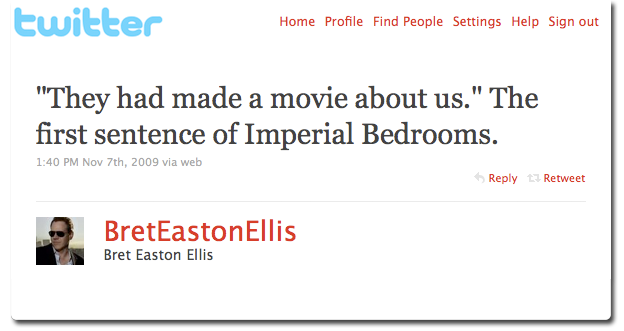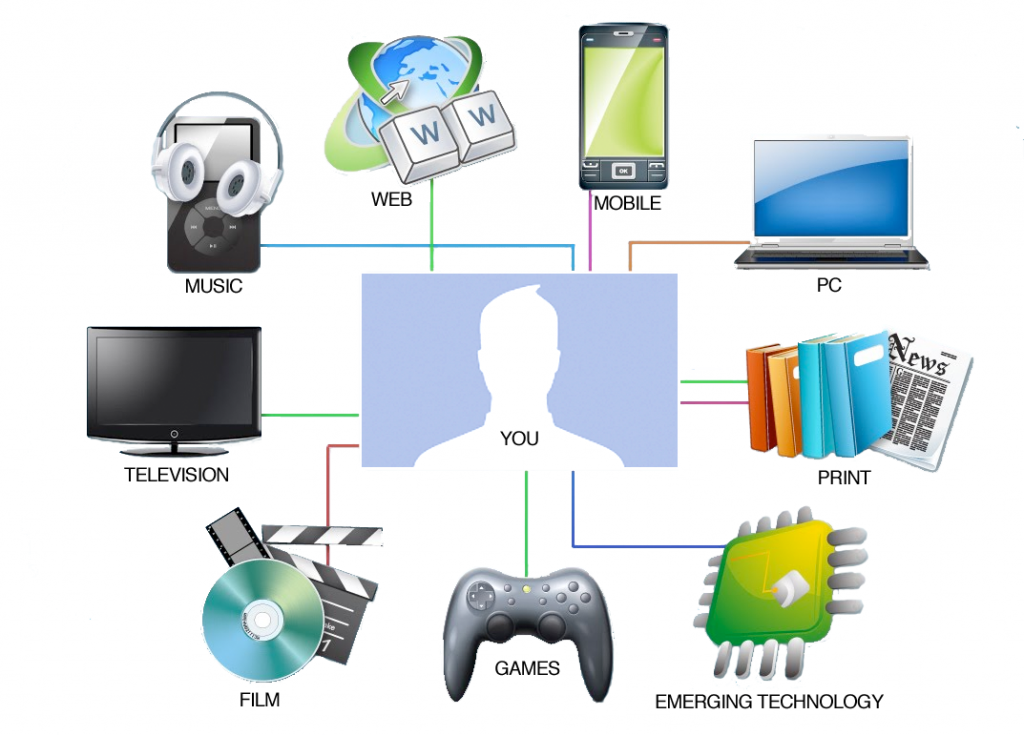
A year ago I wrote a piece called “Your Lifestyle Is An Alternate Reality Game.” An ARG, for short, is an interactive narrative that uses the real world as a platform, often involving multiple media and game elements, to tell a story that may be affected by participants’ ideas or actions. Lifestyle, I suggested, with its proscribed media content, its insider signifiers, its ever-evolving subcultural narrative, is the alternate reality game all of us in the modern world are already playing. Having grown up in the rave scene and then produced nightlife events and music festivals for a decade this similarity was instantly apparent. Since writing that post, I’ve actually seen pioneering ARG creators, Jordan Weisman and Sean Stewart, each, individually liken ARGs to a quintessential alternative culture / music festival experience: Woodstock. (Called it!)
This year, however, the new buzzword gaining popularity for this type of multi-platform narrative is “transmedia.” (On the schedule for the New York DIY Days conference a couple of months ago, the word “transmedia” appeared literally a dozen times in the descriptions for no less than 5 different sessions during the course of the 1-day event). And as the terminology becomes more encompassing — no longer strictly a gaming-specific thing — last year’s thesis needs an upgrade as well: In the digital age, transmedia isn’t just how we create lifestyle narratives, it’s how we experience the narrative of our lives.
.
In 1985, a student at Bennington College named Bret Easton Ellis published what would become a best-selling debut novel called Less Than Zero. It’s a story told in first person by a narrator named Clay, home for Christmas break from a fictional New England liberal arts college, as he wafts through L.A.’s endlessly dissolute desert of affluence, parties, rampant drug use, meaningless sex, and progressively increasing depravity. The book was so insidious and disturbing that by 1987, just two years after its publication, it was turned into an inevitably much less insidious and disturbing movie starring Andrew McCarthy as Clay, Jami Gertz as his ex-girlfriend, Blair, and, notably, Robert Downey Jr. as Clay’s heroin-addicted best friend from high school, Julian, who’d turned to prostitution to pay off his drug debt. Now, 25 years and 5 novels (including The Rules of Attraction and American Psycho) later, Ellis’s newest book, Imperial Bedrooms, out June 15, catches up with Less Than Zero’s original cast of poster-children for morally vacant, excess-addled, existentially corrupted youth in present day, as they inhabit middle age. Once again, Clay is the narrator, once again, he’s just returned to Los Angeles after a semester-length absence, and the first thing Clay says — as classically laconic as his “People are afraid to merge on the freeways in Los Angeles” line that opened Less Than Zero two and a half decades earlier — is: “They had made a movie about us.”
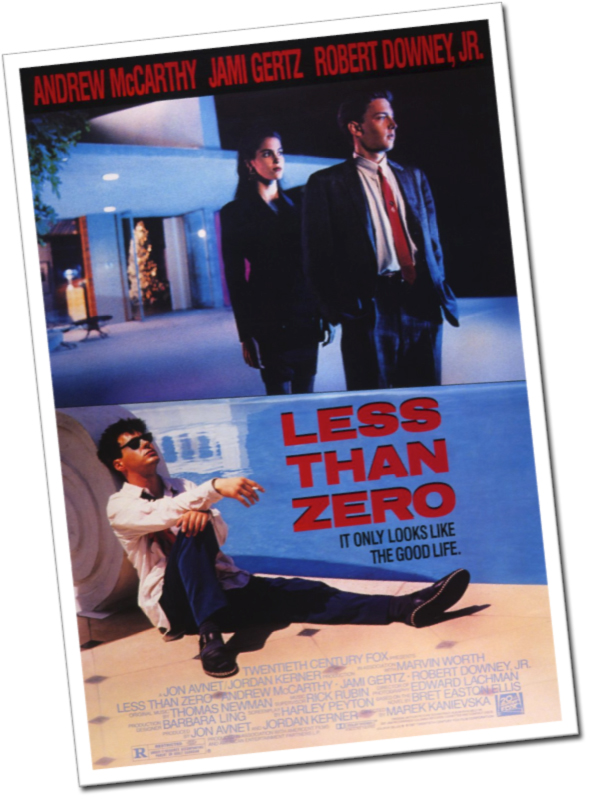
The movie was based on a book written by someone we knew. The book was a simple thing about four weeks in the city we grew up in and for the most part was an accurate portrayal. It was labeled fiction but only a few details had been altered and our names weren’t changed and there was nothing in it that hadn’t happened….
[The author] wasn’t close to any of us… He was simply someone who floated through our lives and didn’t seem to care how flatly he perceived everyone or that he’d shared our secret failures with the world, showcasing the youthful indifference, the gleaming nihilism, glamorizing the horror of it all….
I remember my trepidation about the movie began on a warm October night three weeks prior to its theatrical release, in a screening room on the 20th Century Fox lot. I was sitting between Trent Burroughs and Julian, who wasn’t clean yet and kept biting his nails, squirming in the plush black chair with anticipation…. The movie was very different from the book in that there was nothing from the book in the movie. Despite everything — all the pain I felt, the betrayal — I couldn’t help but recognize a truth while sitting in that screening room. In the book everything about me had happened. The book was something I simply couldn’t disavow. The book was blunt and had an honesty about it, whereas the movie was just a beautiful lie. (It was also a bummer: very colorful and busy but also grim and expensive, and it didn’t recoup its cost when released that November.) In the movie I was played by an actor who actually looked more like me than the character the author portrayed in the book: I wasn’t blond, I wasn’t tan, and neither was the actor. I also suddenly became the movie’s moral compass, spouting AA jargon, castigating everyone’s drug use and trying to save Julian. (“I’ll sell my car,” I warn the actor playing Julian’s dealer. “Whatever it takes.”) This was slightly less true of the adaptation of Blair’s character, played by a girl who actually seemed like she belonged in our group — jittery, sexually available, easily wounded. Julian became the sentimentalized version of himself, acted by a talented, sad-faced clown, who has an affair with Blair and then realizes he has to let her go because I was his best bud. “Be good to her,” Julian tells Clay. “She really deserves it.” The sheer hypocrisy of this scene must have made the author blanch. Smiling secretly to myself with perverse satisfaction when the actor delivered that line, I then glanced at Blair in the darkness of the screening room.
As the movie glided across the giant screen, restlessness began to reverberate in the hushed auditorium. The audience — the book’s actual cast — quickly realized what had happened. The reason the movie dropped everything that made the novel real was because there was no way the parents who ran the studio would ever expose their children in the same black light the book did. The movie was begging for our sympathy whereas the book didn’t give a shit. And attitudes about drugs and sex had shifted quickly from 1985 to 1987 (and a regime change at the studio didn’t help) so the source material — surprisingly conservative despite its surface immorality — had to be reshaped. The best way to look at the movie was as modern eighties noir — the cinematography was breathtaking — and I sighed as it kept streaming forward…. But the thing I remember most about that screening in October twenty years ago was the moment Julian grasped my hand that had gone numb on the armrest separating our seats. He did this because in the book Julian Wells lived but in the movie’s new scenario he had to die. He had to be punished for all of his sins. That’s what the movie demanded. (Later, as a screenwriter, I learned it’s what all movies demanded.) When this scene occurred, in the last ten minutes, Julian looked at me in the darkness, stunned. “I died,” he whispered. “They killed me off.” I waited a beat before sighing, “But you’re still here.” Julian turned back to the screen and soon the movie ended, the credits rolling over the palm trees as I (improbably) take Blair back to my college while Roy Orbison wails a song about how life fades away.
The real Julian Wells didn’t die in a cherry-red convertible, overdosing on a highway in Joshua Tree while a choir soared over the sound track. The real Julian Wells was murdered over twenty years later….
I’d seen what had happened to him in another — and very different — movie.
Transmedia, as USC media studies professor Henry Jenkins describes in his book, Convergence Culture, is storytelling that spans across multiple forms of media, with each element expanding the viewer’s understanding of the story world and creating a new “entry point” through which to become immersed in it. Beyond Ellis’s sheer meta-mindfuckery (and the full, unabridged intro is even moreso), by incorporating the existence of the Less Than Zero movie into Imperial Bedrooms — even detailing the various characters’ reactions to its sanitized inconsistencies with the original novel — he’s effectively turned the film into something other than just the compromised adaptation it’s been for the past 23 years. It’s now a legitimate, if suitably ironic, “entry point” into the Less Than Zero world.
A couple of weeks ago, Jenkins wrote a post called “He-Man and the Masters of Transmedia,” about another fictional world spawned from the 80’s which may have had a lasting affect on my generation:
In many ways, Masters of the Universe was already a transmedia story, at least as much as the technology of the day would allow. He-Man not only appeared in the Filmation-produced cartoons but his story was extended into the mini comic books which came with each action figure, on the collector cards and sticker books and coloring books and kids books.
Once they were removed from their packages, these toys could be mixed and matched to create new kinds of stories….Kids would move from re-performing favorite stories or ritualizing conventional elements from the series to breaking with conventions and creating their own narratives.
I never understood the parents who feared such toys would stifle my son’s imagination because what I observed was very much the opposite – a child learning to appropriate and remix the materials of his culture.
When I speak to the 20 and 30 somethings who are leading the charge for transmedia storytelling, many of them have stories of childhood spent immersed in Dungeons and Dragons or Star Wars, playing with action figures or other franchise related toys, and my own suspicion has always been that such experiences shaped how they thought about stories.
From the beginning, they understood stories less in terms of plots than in terms of clusters of characters and in terms of world building. From the beginning they thought of stories as extending from the screen across platforms and into the physical realm.”
It’s why the website for Imperial Bedrooms has a playlist of songs “from the book” featuring tracks by Randy Newton, Bat for Lashes, Duran Duran, The Fray, Bruce Springsteen, and others — music has always been a key element in Ellis’s fiction: Less Than Zero got its title from an Elvis Costello track, as does its sequel, and there are constant references to songs throughout his novels, cueing a soundtrack in your mind as you’re reading the story. (In fact, all of Ellis’s books now have playlists.) It’s why the Los Angeles Magazine website has an interactive Google map of the locations featured in Imperial Bedrooms and it’s accompanied by Clay’s guide, in his own words, to these various haunts. It’s why Clay has ended up on Facebook and his profile photo — still bearing a decided resemblance to Andrew McCarthy — is also included with his city guide. Here, for instance, is Clay’s take on Hollywood Forever Cemetery:
The most beautiful cemetery in Los Angeles. It’s behind the Paramount lot and it can be disorienting to walk off Gower Avenue into this lush, paradisiacal place. I remember going to movies there during the summer; Psycho, The Muppet Movie, Carrie. I was there last for a funeral where the only person I talked to was Blair.
Meanwhile, in a different genre section of the bookstore, there’s yet another author blurring the lines between fiction, reality, media formats, you know, the ushe: Richard Castle.
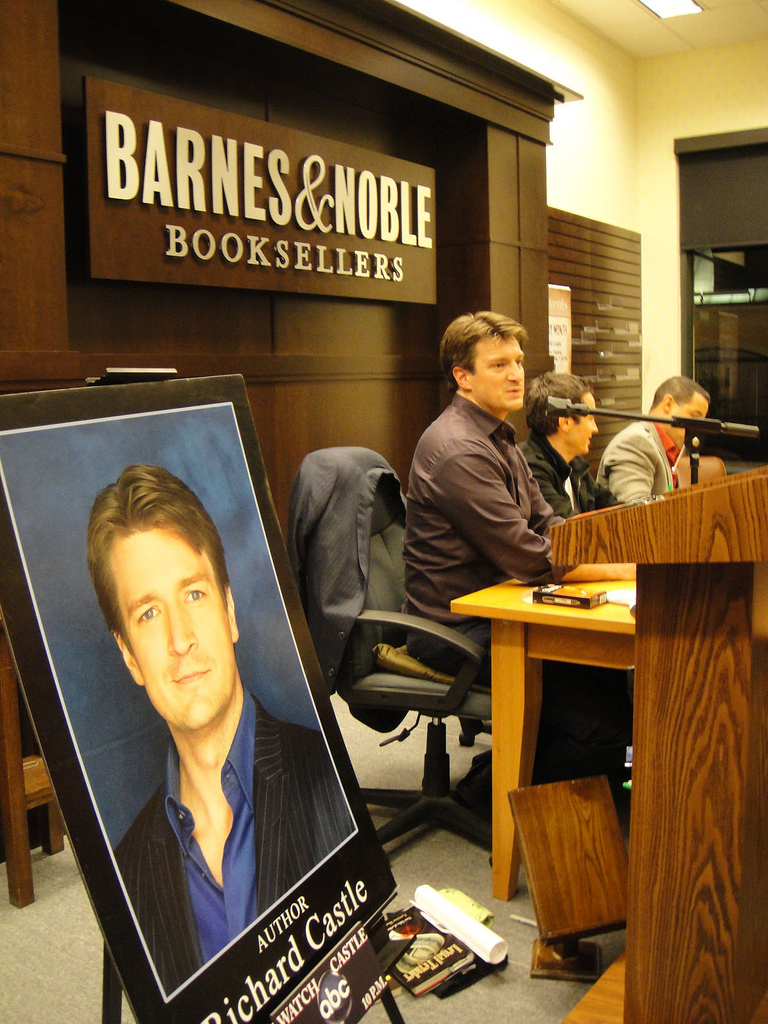
OK, so, technically he’s a TV character played by Nathan Fillion on the ABC show, Castle, which follows the best-selling mystery writer and his unlikely partner, a tough, sexy, NYPD detective named Kate Beckett, as they solve Manhattan murders. The show’s first season story-arc saw the release of Heat Wave, Castle’s new novel about (you know this) a tough, sexy, NYPD homicide detective named Nikki Heat, which also happens to be an actual Hyperion book.
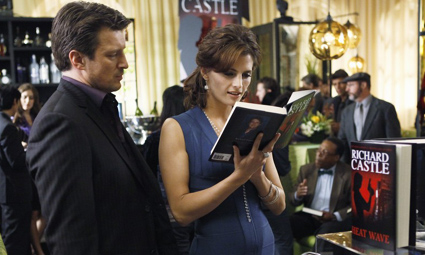
Amazon’s product page for Heat Wave reads:
About the Author
Richard Castle is the author of numerous bestsellers, including the critically acclaimed Derrick Storm series. His first novel, In a Hail of Bullets, published while he was still in college, received the Nom DePlume Society’s prestigious Tom Straw Award for Mystery Literature. Castle currently lives in Manhattan with his daughter and mother, both of whom infuse his life with humor and inspiration.
But Castle isn’t just on TV and bookshelves. Like any 21st century writer who knows what’s up, he’s also on Twitter —
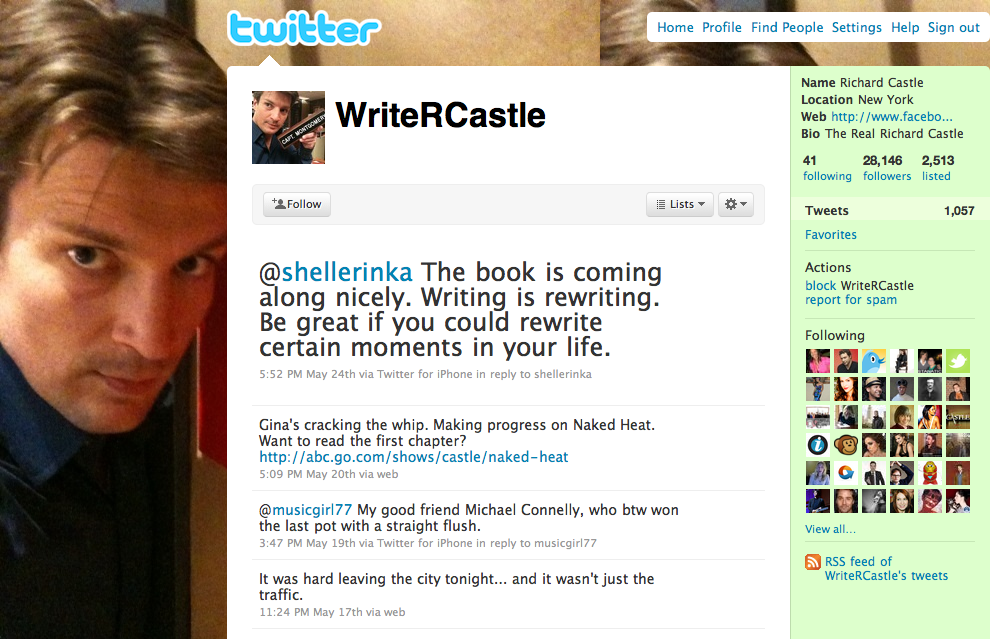
— posting updates to more than 28,000 followers on his writing progress (the second book in the Nikki Heat series is due out in the Fall — “Want to read the first chapter?“), personal life (“Found a button in one of my shoes this morning. And another in a glass of water. Wonder where the other ones flew….“), and personally relevant current events (“Dennis Hopper… iconoclast and patron of the arts… you will be missed.”) You know, like how anyone who isn’t a fictional TV character would use Twitter.
Castle has obviously been designed as a deliberate transmedia narrative, but Imperial Bedrooms wasn’t — it’s just a novel. Either way, it’s inevitable. The human brain has a natural affinity for narrative construction, and it’s incredibly channel agnostic. Once upon a time, the Ancient Greeks heard thunder and believed it to be the sound of Zeus’s thunderbolt. Today, our media formats are just more sophisticated. Our lives are inundated by digital technology, content platforms, network applications — it’s not narratives that travel trans-media: we do. And we bring the stories along for the ride. It’s 2010. All media is transmedia. Deal with it. Rock ‘n’ roll.
Like Sean Stewart says:
Your computer doesn’t care what the 19th century production mechanism for producing your entertainment was. Record, book, it doesn’t care. It’s all 1’s and 0’s to your computer. Video, music, pictures, text, and let’s not stop there, let’s include other things that you can now incorporate as part of your entertainment, like web-pages or searches or email or phone calls directly to your audience. Here’s a simple mnemonic: any way that human-kind has invented to lie to one another should be part of your storytelling toolkit.
But fictional narratives aren’t what this toolkit is strictly limited to. As tech blogger Robert Scoble writes in his recent post, “The ‘like, er, lie’ economy“:
The other day I found myself over at Yelp.com clicking “like” on a bunch of Half Moon Bay restaurants. After a while I noticed that I was only clicking “like” on restaurants that were cool, hip, high end, or had extraordinary experiences.
That’s cool. I’m sure you’re doing the same thing.
But then I started noticing that I wasn’t behaving with integrity. What I was presenting to you wasn’t reality.
See, I like McDonalds and Subway. But I wasn’t clicking like on those. Why not?
Because we want to present ourselves to other people the way we would like to have other people perceive us as.
I’d rather be seen as someone who eats salad at Pasta Moon than someone who eats a Big Mac at McDonalds.
This is the problem with likes and other explicit sharing systems. We lie and we lie our asses off.
We are all storytellers now, all the authors of our own life stories (no big surprise, we’re taking some “creative liberties”). The array of media tools through which to “present ourselves” is already ubiquitous, and constantly expanding. Social networks, personal blogs, microblogs, digital cameras, location-based social applications — for some reason Time Magazine singled out Foursquare as one of the 50 Worst Inventions for being “just another tool tapping into a generation of narcissism,” as if, inexplicably, it’s particularly worse than the cesspools of self-focus that are Facebook or Myspace. With every status update and photo upload and location check-in and “like” we click, we are producing an endless stream of new “entry points” into our personal narratives. And, in turn, like Ellis’s, aptly named, Clay, we are all shaped by the resultant media representations of our selves. In the digital age, transmedia isn’t simply the default for how we experience entertainment, it is how we experience the story of our lives.
